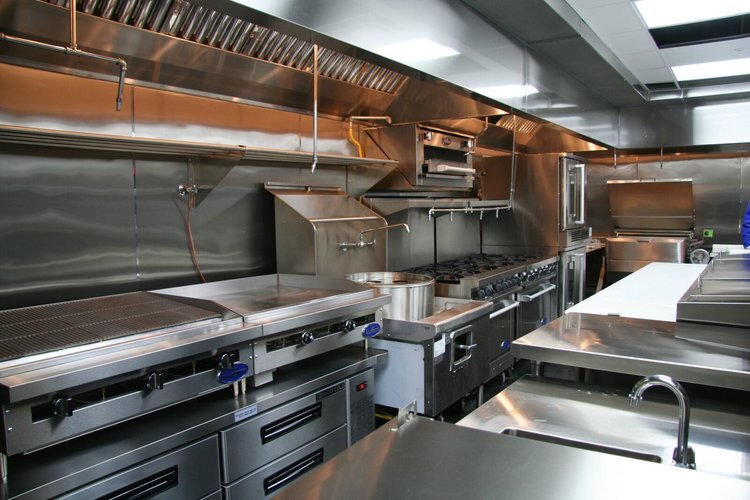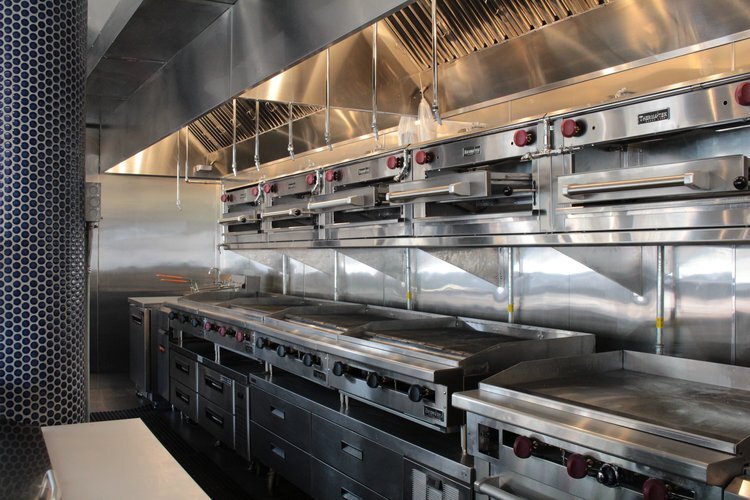
COMMERCIAL KITCHEN EXHAUST HOODS, A TOTALLY INTEGRATED SYSTEM
Building codes distinguish between the cooking processes that produce smoke and grease ( e.g., frying, charbroiling or griddling ) and those that only produce heat and moisture (e.g., steaming, baking and dish washing). Cooking that produces smoke and grease requires a Type I Hood, commonly referred to as a grease hood, which includes a liquid-tight construction and exhaust duct, as well as an automatic fire suppression system. Operations that produce only heat and moisture require a Type II Hood, commonly referred to as a heat or condensate hood, which does not require liquid-tight construction and duct work or a fire suppression system.
GREASE HOODS
Grease hoods are typically constructed of 430 or 304 polished stainless steel, liquid-tight construction complete with baffle type grease filters and a grease trough with a removable grease cup. There are several styles of grease hoods with varying construction features. Wall mounted canopy hoods, island ( single or double ) canopy hoods, and proximity ( back shelf, pass-over or eyebrow ) hoods all have different capture areas and are mounted at different heights and horizontal positions relative to the cooking equipment and listings.
GREASE EXHAUST
Grease exhaust ducts are to be fabricated of min. 16 gauge steel or 18 gauge steel welded liquid-tight, per code. Atlantic Coast Restaurant & Mechanical Services chooses to fabricate our exhaust ducts from 16 gauge galvanized steel because we have found it to be superior to regular steel and ultimately a better product. Our exhaust ducts are specifically designed to meet the needs of our clients and vary from project to project. All duct work is designed with computer aided programs, fabricated with plasma cutting systems, and assembled with machinery.
HEAT/CONDENSATE HOODS & HEAT HOOD EXHAUST DUCTS
Heat hoods are typically constructed of 430 or 304 polished stainless steel. Heat hood exhaust ducts are typically fabricated of min. 26 or 24 gauge galvanized steel.
CONDENSATE HOOD EXHAUST DUCTS
Heat hood exhaust ducts are typically fabricated of min. 20 gauge stainless steel welded liquid-tight, due to the nature of a condensate hood and the conveyance of water vapor. We do not want the duct work to leak or rust.
SUPPLY DUCT
Supply ducts, for most typical hood systems, are typically fabricated of min. 26 or 24 gauge galvanized steel.
EXHAUST FANS
There are two typical types of exhaust fans for the removal of grease laden vapors. The Upblast Exhaust Fan is typically found mounted on rooftops or walls and are constructed using aluminum. The Utility Set Exhaust Fan is typically used inline or on rooftops and are constructed using steel. Both are acceptable for the removal of grease laden vapors, just used in different types of installations.
SUPPLY FANS
Supply fans are designed to bring back approximately 80% to 90% of the air being exhausted. There are two typical types of supply fans used in bringing back or introducing air back into the kitchen. The Box Style Fan is typically found mounted on rooftops or walls. Whereas, the Inline Fan is used inside the building. Fans are generally constructed using steel or aluminum boxes with a blower and motor section mounted inside.
LISTED VS UNLISTED
Listed hoods are tested against a recognized standard. Underwriters Laboratories (UL) Standard 710 dictates the material and design requirements similar to those in the building code and has a performance test requirement for the capture and containment of the thermal plume.
Unlisted hoods must meet the prescriptive materials and design requirements of the local building (FBC) and health codes. In addition they must be operated at exhaust rates dictated by the local building code (FBC).





